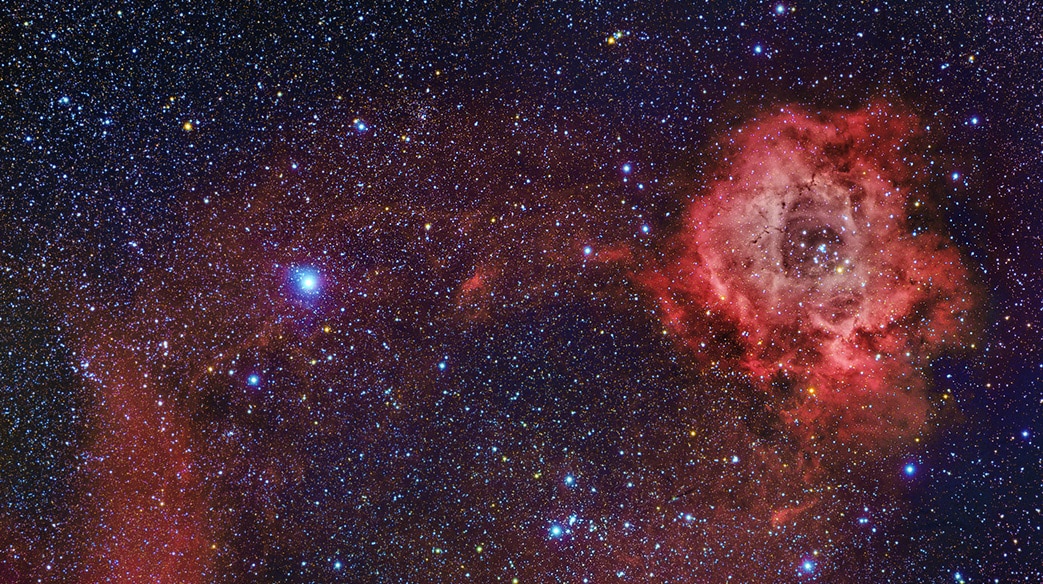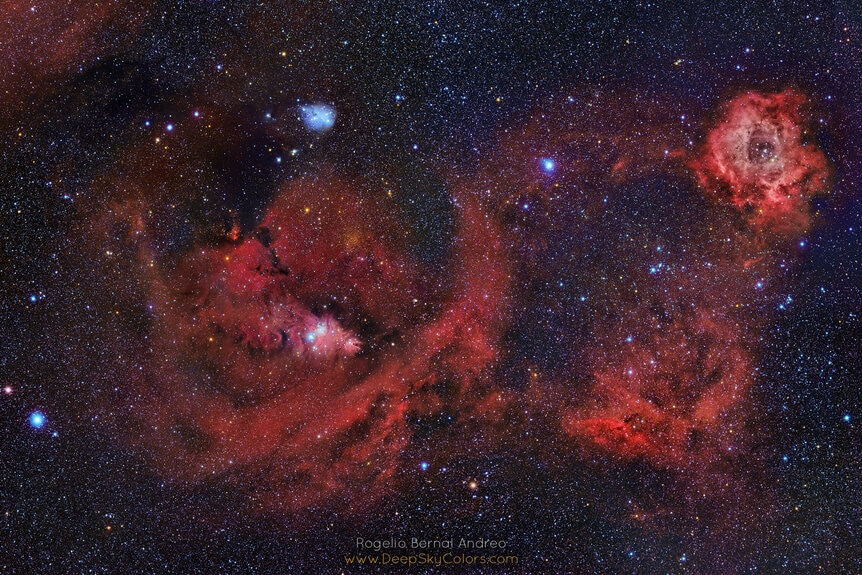Create a free profile to get unlimited access to exclusive videos, sweepstakes, and more!
A rose for Valentine’s Day... a really, really big rose

Today is Valentine's Day, and one traditional gift under such circumstances is a single rose. It's a lovely gesture: personal, intimate, even understated.
Unless, of course, it's a rose 1.3 quadrillion kilometers wide. That's more of a what I would call grand gesture.
So, may I present to you the Rosette Nebula, a red bloom 5,000 light-years away and 130 light-years in diameter?
[It's a big file; give it a sec to load.]
This image was taken by my pal Rogelio Andreo Bernal, who is a master at taking breathtaking deep-sky images (in fact, his website is called Deep Sky Colors). The Rosette is to the upper right, the roughly circular gas cloud with the hole in its center*. The circular shape is a projection effect; the nebula is actually more spherical (in fact astronomers call these Strömgren spheres), and we see it as a circle on the sky.
The hole in the center is real, though. The Rosette is a star-forming cloud, and form there they do: NGC 2244, the cluster in the center of the nebula, contains several thousand stars, including a couple of terrifyingly beefy ones that blast out hundreds of thousands of times the energy the Sun does. If the Earth orbited one of them at the same distance it does from the Sun, we'd be blasted to vapor. Not very romantic.
But … The immense output of these stars, plus the fierce winds of subatomic particles they blow out, have carved that cavity in the center of the nebula. Also, their light is what causes the red glow of the gas around them, energizing the hydrogen in it and making it shine literally like a neon sign (we call these emission nebulae). So those stars are what are making the Rosette rose-shaped, which is kinda romantic.
Like love itself the Universe can be both wondrous and painful. And a little confusing.
Of course, the Rosette is just one part of this magnificent vista. The left side is dominated by NGC 2264, a sprawling emission nebula lying about half the distance from Earth to the Rosette. In the very center of this cloud are the Cone Nebula and the Christmas Tree Cluster, dwarfed on this scale by the gas around them. The arc-shaped feature swooping from the center of the image to the lower left and back up again is interesting: That may be material piled up by the winds from the stars in the center of NGC 2264, what astronomers call "snow-plowing," since the effect is the same as a plow pushing snow in front of it.
Above that is a lovely little nebula glowing blue. The color is the call sign of a reflection nebula, a cloud of dust reflecting light from nearby stars. These stars tend to be bright and blue. That light gets scattered toward us by the dust in the cloud, similar to how air molecules scatter blue light from the Sun, making the sky look blue.
I fired up some planetarium software to find out what this nebula was, but couldn't find it at first! A bit of sleuthing (going to the astronomical database SIMBAD, getting the coordinates of the nebula's location, and then feeding that back into the database) yielded its name: IC 2169 (though, confusingly, I also see it listed as IC 447; I found a lovely close-up of it here, taken by Rick Beno).
Having my confidence boosted by this detective work, I then turned my eyes to the red nebula to the lower right, below the Rosette (which coincidentally looks more like a rosebud seen from the side). However, my efforts came up empty. There's a dark cloud in it to the left (a dense knot of dust so thick it blocks light from stars and gas behind it), which I was able to figure out is LDN 1631 (for Lynds' Dark Nebula, a catalog of such beasties), but I have no clue if the whole emission nebula has a name or not!
A rose, by any name or not, would still smell as sweet.
Having said all this, I know that Valentine's Day is laden with issues; some people love the romanticism of it, while others decry the forced sentimentality and commercial nature of it (which is true of nearly every holiday, truthfully).
Whether you celebrate it or not, love it or hate it, that's fine by me. But if it gives me an excuse to post gorgeous images of the sky, take you on a small tour of them, and perhaps explain a little bit of the wondrous nature of them, why then, to me that's romance.
P.S. If you're shopping online for a last-minute gift, please consider using this link on Amazon; when you do so Amazon donates some of the proceeds to one of my favorite groups, Astronomers Without Borders.
* Around my house, donuts are a more widely used holiday gift.















